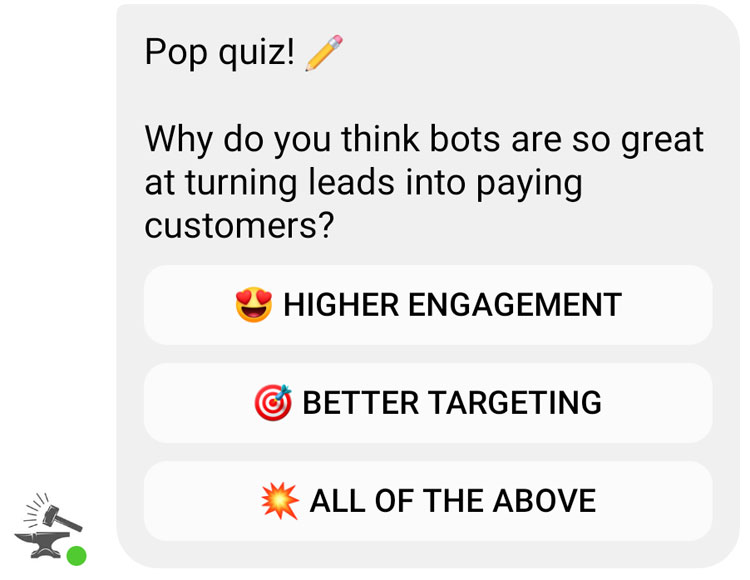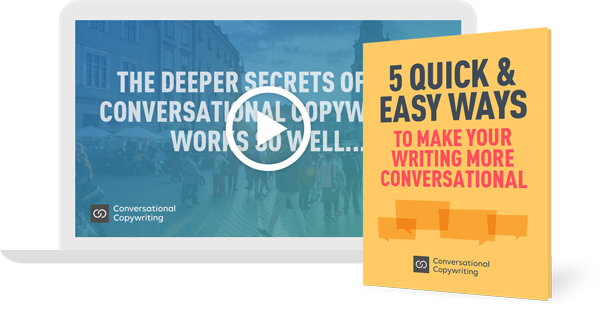
Over the last two or three weeks I’ve been spending a lot of time working on chatbots.
I’ve co-founded a chatbot agency, and I’ve written a number of chatbot scripts.
The more time I spend writing these scripts, the more I see shifts in how I write conversational copy for longer-form channels, like email and web pages.
It’s like the lessons I learn from writing for bots are flowing into everything else I do.
Here are three of the ways chatbot copywriting is shifting the way I write.
I try to imagine the reader’s half of the conversation.
When you’re writing the script for a rules-based chatbot, you’re writing both halves of a conversation.
You write your part, and then the user selects one of several answers to a simple question.
It looks like this…

While this may not be a “real” conversation, it does have a few of the attributes of the real thing.
- You’re creating a sense of back and forth.
- You’re taking turns.
- You’re pausing between each turn in the conversation.
- And you’re including the reader by giving them control over the direction the conversation takes.
I can’t do those things when I’m writing an email or sales page. I can’t have someone else participate while they read it.
But I CAN make sure I always imagine that person sitting in front of me.
I CAN try to imagine the questions they might ask while reading my copy.
I CAN try to imagine why and when they might want to jump in, take their turn, and respond to what I’m saying.
All that informs the way I write.
Writing for bots has helped me improve my listening skills as a writer..
Emojis remind me to touch my readers’ emotions
A fun part of writing a chatbot script is that it can include visual elements, like emojis, animated GIFs and images.
Emojis are emotional by definition. Smile, frown… give a thumbs up.
As for animated GIFs, they’re almost always created to make you smile or laugh.
Remember… we’re talking about texting here.
Every day we text friends and family members. Maybe colleagues too. And we include emojis and GIFs as a kind of emotional shorthand.
If I’m writing something else, like this post, I can include emojis if I want. 😃 👍
But it’s not the same. They’re out of context.
Even so, writing bot scripts reminds me how important it is to connect with my readers on an emotional level.
For longer-form text I might try to achieve the same emotions by telling a quick story.
Anything to make your readers feel something, to connect with them emotionally.
I keep my writing shorter.
When you write for a bot, you’re writing short text.
Really short.
It’s the nature of the channel.
For most writers, that can be quite a challenge.
But you have to master short-form writing, because texting is no place for long descriptions or endless blah blah blah.
You need a very clear idea of what you’re going to say.
You need to use short words and short sentences.
No ambiguity. No uncertainty.
It’s harder than it looks!
But as you get a little better at it, you begin to look at all your other writing work through a slightly different lens.
You see how long-winded you are sometimes.
And you remind yourself that your audience will almost always prefer that you find a shorter and faster version.
This is about a shift in mindset.
I listen more now. I try to hear what my readers might be thinking or asking.
I try to do a better job of getting plugged in emotionally.
And I keep things simple.
Writing for bots is a great way to improve your writing overall.
Over the weeks and months to come I’ll come back and share more about what I’m discovering along the way.
Stay tuned. : )

When you anticipate the answers it focuses the question – I love writing chat bots
To me it seems that writing scripts for bots is a little bit like writing fiction dialogue between two human characters. The writer has to come up with both parts of the conversation.